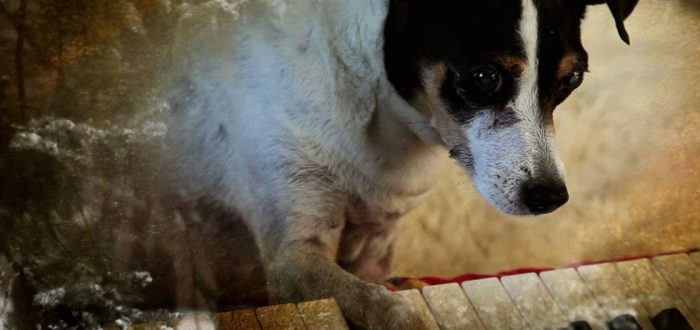A stream-of-consciousness love letter to a dog that turns into a rumination on life, death, and everything in between, Laurie Anderson’s Heart of a Dog is certainly an intriguing experimental documentary. Anderson, an artist and the partner of the late Lou Reed (who passed away during the extended production period of this feature), draws upon self-shot video, artworks, news reports, surveillance footage, re-enactments, poetry, literature, and photographs – amongst other things – to create a sprawling collage documenting the life and passing of her dog Lolabelle as a means of mythologising her, assisting her passage into the afterlife.1
Anderson’s film is scattershot at best, which actually is a major part of its appeal. It opens on a collection of abstract animated paintings, which depict Anderson delivering the introduction to the film we are watching. From here we move to a focus on Lolabelle, particularly her later years, before Anderson begins to philosophise about September 11, the film switching modes into somewhat of an eerie 9/11 conspiracy theory doco. The aftermath of that event reverberates throughout the rest of the feature, as Anderson draws parallels between Lolabelle in her later life and the United States in a fearful, post-September 11 climate. One particular sequence sees her discussing an eagle attack on her dog, a rat terrier and born pack protector, which changed the way in which Lolabelle approached protection, suddenly made aware of danger from above. This, she posits, is mirrored in America, as individuals realised that attacks on their way of live could now come from the skies.
This thesis is not a constant however, with Anderson also ruminating on more trivial times with her pup, who had a personal trainer and learned to “play” piano in its later years. As the film progresses, the film’s central arguments become even more abstract, as Anderson introduces discussions surrounding the Tibetan Book of the Dead and begins to reflect on own life. Thematically, the film hinges on the idea of grief, and the notion of “feeling sad without being sad” as a way of responding to death. It is in the exploration of this theme that Heart of a Dog shines, a film that addresses death without pushing for any tear-jerker moments.
Anderson’s messy approach to filmmaking works much better than it probably should, managing to balance its broad self-indulgences with interesting observations and impactful statements. Anderson’s style seems to have its roots in the groundbreaking laptop edited documentary Tarnation, which was constructed entirely in iMovie by director Jonathan Caouette on a budget of $218.32. Like Heart of a Dog, Tarnation was also a highly personal film – albeit, one with a far more conventional narrative – tracking the relationship between Caouette and his mother, who suffered from numerous mental illnesses, through hours upon hours of home movie footage. Anderson seems to have borrowed this framework and taken Caouette’s experiment one step further, towards an even stronger artistic abstraction, even in spite of the linearity of her described experience with Lolabelle.
That she has done so with a budget far higher than Caouette’s should raise questions of its construction and, perhaps even, the legitimacy of its intimate narrative. At times, it is hard to take seriously, as she describes experiences with her family pet that are so far removed from the experiences of most people, her wealth fully on display, that actually stifles engagement: early on in the feature she describes going on a holiday with the intention of forming a stronger connection with Lolabelle; at the end of Lolabelle’s life, she consults her Buddhist teacher about the appropriate course of action in regards to euthanasia. All of these experiences (and the creation of a long term documentary project like this) come from a place of immense privilege and should see us question the relationship between viewer and creator. Thankfully – probably due to Anderson’s creative positioning of the film outside of the scope of other similar ventures – these issues can only minor ones, as the journey, rather than the specific content, takes centre stage.
Overall, Anderson’s film is a mostly compelling venture that will capture the imagination of some, and appall and alienate others. While Heart of a Dog is not without its problems, the fact that Anderson manages to conjure a satisfying semblance of finality from the conclusion of her sprawling and joyfully messy narrative speaks volumes of the talent on display here – even if it may not be evident in every frame.
Around the Staff
| Megan Nash |

